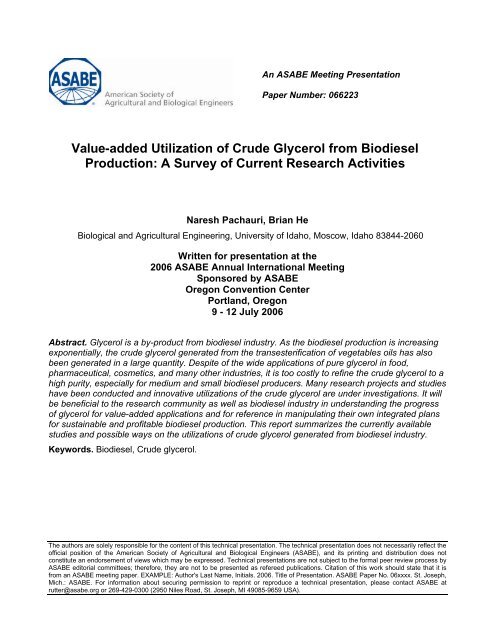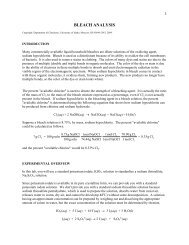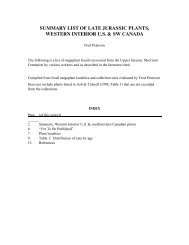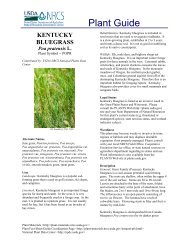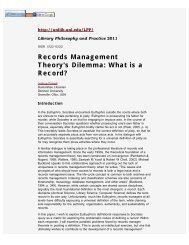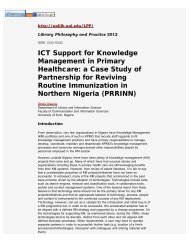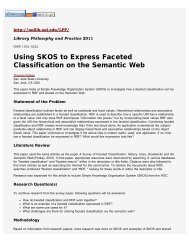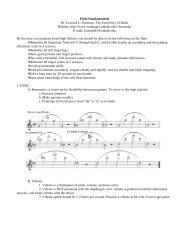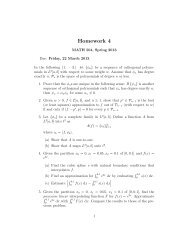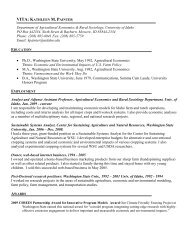Value-added Utilization of Crude Glycerol from Biodiesel Production ...
Value-added Utilization of Crude Glycerol from Biodiesel Production ...
Value-added Utilization of Crude Glycerol from Biodiesel Production ...
Create successful ePaper yourself
Turn your PDF publications into a flip-book with our unique Google optimized e-Paper software.
An ASABE Meeting Presentation<br />
Paper Number: 066223<br />
<strong>Value</strong>-<strong>added</strong> <strong>Utilization</strong> <strong>of</strong> <strong>Crude</strong> <strong>Glycerol</strong> <strong>from</strong> <strong>Biodiesel</strong><br />
<strong>Production</strong>: A Survey <strong>of</strong> Current Research Activities<br />
Naresh Pachauri, Brian He<br />
Biological and Agricultural Engineering, University <strong>of</strong> Idaho, Moscow, Idaho 83844-2060<br />
Written for presentation at the<br />
2006 ASABE Annual International Meeting<br />
Sponsored by ASABE<br />
Oregon Convention Center<br />
Portland, Oregon<br />
9 - 12 July 2006<br />
Abstract. <strong>Glycerol</strong> is a by-product <strong>from</strong> biodiesel industry. As the biodiesel production is increasing<br />
exponentially, the crude glycerol generated <strong>from</strong> the transesterification <strong>of</strong> vegetables oils has also<br />
been generated in a large quantity. Despite <strong>of</strong> the wide applications <strong>of</strong> pure glycerol in food,<br />
pharmaceutical, cosmetics, and many other industries, it is too costly to refine the crude glycerol to a<br />
high purity, especially for medium and small biodiesel producers. Many research projects and studies<br />
have been conducted and innovative utilizations <strong>of</strong> the crude glycerol are under investigations. It will<br />
be beneficial to the research community as well as biodiesel industry in understanding the progress<br />
<strong>of</strong> glycerol for value-<strong>added</strong> applications and for reference in manipulating their own integrated plans<br />
for sustainable and pr<strong>of</strong>itable biodiesel production. This report summarizes the currently available<br />
studies and possible ways on the utilizations <strong>of</strong> crude glycerol generated <strong>from</strong> biodiesel industry.<br />
Keywords. <strong>Biodiesel</strong>, <strong>Crude</strong> glycerol.<br />
The authors are solely responsible for the content <strong>of</strong> this technical presentation. The technical presentation does not necessarily reflect the<br />
<strong>of</strong>ficial position <strong>of</strong> the American Society <strong>of</strong> Agricultural and Biological Engineers (ASABE), and its printing and distribution does not<br />
constitute an endorsement <strong>of</strong> views which may be expressed. Technical presentations are not subject to the formal peer review process by<br />
ASABE editorial committees; therefore, they are not to be presented as refereed publications. Citation <strong>of</strong> this work should state that it is<br />
<strong>from</strong> an ASABE meeting paper. EXAMPLE: Author's Last Name, Initials. 2006. Title <strong>of</strong> Presentation. ASABE Paper No. 06xxxx. St. Joseph,<br />
Mich.: ASABE. For information about securing permission to reprint or reproduce a technical presentation, please contact ASABE at<br />
rutter@asabe.org or 269-429-0300 (2950 Niles Road, St. Joseph, MI 49085-9659 USA).
Introduction<br />
<strong>Biodiesel</strong> production in the United States has increased dramatically <strong>from</strong> 500,000 gallons in 1999 to 70<br />
million gallons in 2005 (National biodiesel Board, 2006). The principal by–product <strong>of</strong> biodiesel production<br />
is the crude glycerol, which is about 10 %wt <strong>of</strong> vegetable oil (Dasari et al., 2005). For a current biodiesel<br />
production <strong>of</strong> 150 million gallons/year, the glycerol amount is 50 million kg High purity glycerol is a very<br />
important industrial feedstock. Its applications are found in food, drug, cosmetic and tobacco industries. In<br />
the past decade, industrial glycerol price was in the range <strong>of</strong> $1.28 to $1.65 (Kirk-Othmer Encyclopedia <strong>of</strong><br />
Chemical Technology, 2004). However, crude glycerol derived <strong>from</strong> biodiesel production possesses very<br />
low value because <strong>of</strong> the impurities. Further refining <strong>of</strong> the crude glycerol will depend on the economy <strong>of</strong><br />
production scale and/or the availability <strong>of</strong> a glycerol purification facility. Larger scale biodiesel producers<br />
refine their crude glycerol and move it to markets in other industries. It is generally treated and refined<br />
through filtration, chemical additions, and fractional vacuum distillation to yield various commercial<br />
grades. If it used in food, cosmetics, and drugs, further purifications are needed such as bleaching,<br />
deodoring, and ion exchange to remove trace properties. Purifying it to that stage, however, is costly and<br />
generally out <strong>of</strong> the range <strong>of</strong> economic feasibility for the small to medium sized plants. As more and more<br />
crude glycerol is continuously generated <strong>from</strong> the biodiesel industry, it is very important that economical<br />
ways <strong>of</strong> the low-grade glycerol utilization be explored to further defray the cost <strong>of</strong> biodiesel production in<br />
the growing global market.<br />
Basic <strong>Glycerol</strong> Chemistry<br />
<strong>Glycerol</strong>, or 1,2,3-propanetriol, is a trihydric alcohol. It is a colorless, odorless, sweet-tasting, syrupy<br />
liquid. It melts at 17.8°C, boils with decomposition at 290°C, and is miscible with water and ethanol (Perry<br />
and Green, 1997). The chemical formula for glycerol is<br />
OH-CH 2 -CH (OH)-CH 2 -OH<br />
It is hygroscopic; i.e., it absorbs water <strong>from</strong> the air; this property makes it valuable as a moistener in<br />
cosmetics. <strong>Glycerol</strong> is present in the form <strong>of</strong> its esters (glycerides) in all animal and vegetable fats and<br />
oils.<br />
<strong>Glycerol</strong> <strong>Utilization</strong> for Specific Products<br />
For every 9 kg <strong>of</strong> biodiesel produced, about 1 kg <strong>of</strong> a crude glycerol by-product is formed (Dasari et al.,<br />
2005). The usage <strong>of</strong> low-grade quality <strong>of</strong> glycerol obtained <strong>from</strong> biodiesel production is a big challenge as<br />
this glycerol cannot be used for direct food and cosmetic uses. An effective usage or conversion <strong>of</strong> crude<br />
glycerol to specific products will cut down the biodiesel production costs. This paper aims to cover<br />
possible conversion <strong>of</strong> glycerol into useful products. The products are 1,3-propanediol, 1,2-propanediol,<br />
dihydroxyacetones, hydrogen, polyglycerols, succinic acid, and polyesters. <strong>Glycerol</strong>, when used in<br />
combination with other compounds yields other useful products. For example glycerol and ethylene glycol<br />
together can be used as a solvent for alkaline treatment <strong>of</strong> poly fabrics (Yang and Tsai, 1997). <strong>Glycerol</strong><br />
reductions with magnesium synthesize the carbon onions (Du et al., 2005). <strong>Glycerol</strong> can be used as<br />
dielectric medium for compact pulse power systems (Brown et al., 1999). <strong>Glycerol</strong> acts as a medium in<br />
electrodeposition <strong>of</strong> Indium-Antimony alloys <strong>from</strong> chloride tartrate solutions (Kochegarov and Belitskaya,<br />
1971). Biomass is converted to liquid fuel using glycerol that can be blended with gasoline as an<br />
alternative fuel (Demirbas, 2000). Mixed culture fermentation <strong>of</strong> glycerol synthesizes short and medium<br />
chain polyhydroxyalkanoate blends (Koller et al., 2005).<br />
Products <strong>from</strong> <strong>Glycerol</strong><br />
1,3-propanediol<br />
1,3-propanediol is a simple organic chemical. The high cost and limited availability has restricted its<br />
commercial use. 1,3-propanediol has numerous uses. It can be formulated into composites, adhesives,<br />
laminates, powder and UV-cured coatings, mouldings, novel aliphatic polyesters, co-polyesters, solvents,<br />
2
anti-freeze and other end uses (Shell Chemicals, 2006). One <strong>of</strong> the most successful applications has<br />
been in the formulation <strong>of</strong> corterra polymers. As the production is limited and costs are higher, glycerol<br />
has become an attractive feedstock for production <strong>of</strong> for 1,3-propanediol. Microbial fermentation is an<br />
important technology for the conversion <strong>of</strong> renewable resources to chemicals. It can be obtained by<br />
microbial fermentation <strong>of</strong> glycerol. Propanediol-based polymers exhibit better properties than those<br />
produced <strong>from</strong> 1,2-propanediol, butanediol or ethylene glycol.<br />
Using Clostridium Butyricum<br />
Himmi et al. (1999) did batch fermentations to produce 1,3-propanediol. To study the glycerol conversion,<br />
three types <strong>of</strong> media were used: a rich medium, a low-nutrient medium (LNM), and when biotin was<br />
replaced by yeast extract in the LNM (LNM-YE). To study fermentation at the pilot scale, cultures were<br />
carried out using a 20 L reactor with 17 L useful volume. It was equipped with a boiler to produce steam<br />
for in situ sterilization <strong>of</strong> the culture medium and reactor piping. The culture inoculum consisted <strong>of</strong> 11 (6%<br />
vol) <strong>of</strong> pH-controlled inoculum culture using industrial glycerin equivalent to 50 g/l <strong>of</strong> pure glycerol. To<br />
determine an adequate nitrogen level for glycerol fermentation by Clostridium Butyricum, NH4CI was<br />
<strong>added</strong> to LNM in various amounts, and pH-controlled cultures were performed with high concentrations <strong>of</strong><br />
glycerol corresponding to an initial C/N ratio between 60:1 and 112:1. Biotin <strong>of</strong> 4 µg/L was sufficient to<br />
convert 129 g/L <strong>of</strong> glycerol and 121 g/L <strong>of</strong> industrial glycerin into a large amount <strong>of</strong> 1,3-propanediol. In the<br />
proposed medium nitrogen constituted a limiting factor for glycerol fermentation, especially when the C/N<br />
ratio was less than 81:1. Papanikolaou and Aggelis (2003) simulated the production <strong>of</strong> 1,3-propanediol by<br />
Clostridium Butyricum strain F2b <strong>from</strong> raw glycerol by a Contois-type model. The production <strong>of</strong> 1,3propanediol<br />
by Clostridium Butyricum F2b was suitable for this type <strong>of</strong> bioconversion. It was found that<br />
the maximum theoretical 1,3-propanediol productivity was comparable with the highest one achieved<br />
during growth <strong>of</strong> various bacterial strains on pure glycerol in batch and continuous cultures. Papanikolaou<br />
et al. (2000) carried out batch and continuous cultures <strong>of</strong> a newly isolated Clostridium Butyricum strain.<br />
The preculture was carried out in 100 mL conical flasks, filled with 50 mL <strong>of</strong> medium (the carbon source<br />
was 30 g/L <strong>of</strong> pure glycerol), inoculated with the first post-sporal Hungate-tube culture and incubated at<br />
33°C without agitation for 10-14 h. Batch and single-stage continuous cultures were conducted in a 2 L<br />
reactor filled with 0.9 L <strong>of</strong> medium and inoculated with 0.1 L <strong>of</strong> preculture. In order to ascertain the<br />
anaerobiosis during the first fermentation steps <strong>of</strong> the fermentor culture, nitrogen gas, at a rate <strong>of</strong> 0.5<br />
vvm, was infused into the culture medium. The agitation speed was 200 rpm and the pH was adjusted to<br />
7±0.05 by automatic addition <strong>of</strong> 2 N KOH. The incubation temperature was 33°C. A two-stage continuous<br />
culture seemed attractive for achieving simultaneously high product concentration and productivity. The<br />
first stage presented a high dilution rate in order to obtain an increased 1,3-propanediol volumetric<br />
productivity. The second stage with a lower dilution rate, served mainly to further increase the product<br />
concentration. Significant cell growth was observed in the first stage <strong>of</strong> the culture, whereas at the high<br />
flow rates significant substrate amounts remained unconsumed in the culture fluid. For both types <strong>of</strong><br />
cultures, the conversion yield obtained was around 0.55 g <strong>of</strong> 1,3-propanediol formed per 1 g <strong>of</strong> glycerol<br />
consumed. The highest 1,3-propanediol concentration for single stage process was 35-48 g/L. They<br />
found that 1,3-propanediol was associated with cell growth whereas acetate and butyrate seemed non<br />
growth-associated products. Low and medium dilution rates up to 0.1/hr favored butyrate production<br />
whereas at higher rates acetate production increased. The maximum 1,3-propanediol volumetric<br />
productivity obtained was 5.5 g/L�h. In a two-stage continuous fermentation, the first stage presented high<br />
1,3-propanediol volumetric productivity, whereas the second stage (with a lower dilution rate) increased<br />
the final product concentration. High 1,3-propanediol concentrations were achieved (41-46 g/L), with a<br />
maximum volumetric productivity <strong>of</strong> 3.4 g/L�h. A cell concentration decrease was reported between the<br />
second and the first fermentor. For Batch and Continuous cultures, Zeng (1997) obtained conversion<br />
around 0.55 g <strong>of</strong> 1,3-propanediol formed per 1 g <strong>of</strong> glycerol consumed. Zeng (1996) calculated theoretical<br />
maximum yield <strong>of</strong> 0.72 mol/mol glycerol without any hydrogen and butyric acid formation. The product<br />
concentration and productivity <strong>of</strong> 1,3-propanediol by Clostridium Butyricum was far below the optimum<br />
performance on comparing the experimental results with theoretical calculations using Klebsiella<br />
Pneumoniae due to the relatively high formation <strong>of</strong> butyric acid.<br />
3
Using Klebsiella Pneumoniae<br />
Another microorganism that ferments glycerol to 1,3-propanediol is Klebsiella Pneumoniae.<br />
Xiu et al. (2004) optimized the conditions <strong>of</strong> batch and continuous fermentations on the basis <strong>of</strong><br />
volumetric productivity <strong>of</strong> 1,3-propanediol. Their mathematical model was based on growth kinetics <strong>of</strong><br />
multiple inhibitions and the metabolic overflow <strong>of</strong> substrate consumption and product formation. They<br />
found the optimal initial glycerol concentration to be 960 mmol/L with a given inoculation <strong>of</strong> 0.1 g<br />
biomass/L, for the batch culture leading to the highest volumetric productivity (52.6 mmol/L�h) <strong>of</strong> 1,3propanediol.<br />
For continuous fermentations, the optimal dilution rate and initial glycerol concentration in<br />
feed were 0.29/h and 731 mmol/L, respectively. The productivity was 114 mmol/ L�h that was more than<br />
twice the productivity <strong>of</strong> an optimal batch culture. They proposed two-stage continuous process in which<br />
the first stage was operated at the optimal conditions and the second one was used to consume the<br />
residual glycerol in the first one. The dilution rate was higher in the second stage than in the first one. A<br />
two-step bioprocess <strong>of</strong> two bioreactors in series appeared to be more favorable than a single bioreactor<br />
system with the same volume in terms <strong>of</strong> the concentration, yield and productivity <strong>of</strong> 1,3-propanediol.<br />
Chen et al. (2005) study showed that the increment <strong>of</strong> key enzyme activities is essential to 1,3-<br />
Propanediol formation. Fermentation conditions <strong>of</strong> key enzymes <strong>of</strong> 1,3-Propanediol production by<br />
Klebsiella Pneumoniae were studied under microaerobic condition. Before inoculation, the strain was<br />
incubated for 24 h at 37°C in 250 mL shake flasks containing 50 mL <strong>of</strong> preculture medium with shaker<br />
speed 120 rpm under aerobic conditions. Uniform design and genetic algorithms and coupling artificial<br />
neural networks were developed for the medium optimization. When the strain grew in the optimized<br />
medium under optimal fermentation condition in a 5 L stirred tank bioreactor for batch production, glycerol<br />
dehydrogenase (GDH), 1,3-propanediol oxidoreductase (PDOR) and glycerol dehydratase (GDHt)<br />
activities were 3700, 3840 and 8.70 U referred to 1 L <strong>of</strong> fermentation broth after 20 h cultivation and the<br />
productivities <strong>of</strong> GDH, PDOR and GDHt (U/L h) were 185, 192, 0.435 and the maximum concentration <strong>of</strong><br />
1,3-Propanediol was 10.5 g/L. Chen et al. (2004) examined different carbon sources, organic nutrients,<br />
nitrogen sources and salts for their effects on key enzymes formation for fermentation. According to them<br />
the optimal medium ingredients were glycerol 30 g/L, KCl 1.6 g/L, NH4Cl 6.7 g/L, CaCl2 0.28 g/L and<br />
yeast extract 2.8 g/L. The optimum operating conditions were 37°C, initial pH <strong>of</strong> 7.0, shaker speed <strong>of</strong> 200<br />
rpm as well as 5% inoculum. The results suggested that appearance <strong>of</strong> maximum activities <strong>of</strong> key<br />
enzymes is earlier than that <strong>of</strong> maximum concentration <strong>of</strong> 1,3-propanediol. Chen et al. (2003) studied the<br />
glycerol metabolism by analyzing according to energy (ATP), reducing equivalent and product balances.<br />
Their theoretical analysis showed that a microaerobic condition was more perfect for the production <strong>of</strong><br />
1,3-propanediol <strong>from</strong> glycerol than anaerobic and aerobic conditions. The yields <strong>of</strong> 1,3-propanediol,<br />
biomass and ATP to glycerol under microaerobic conditions depend on the molar fraction <strong>of</strong> reducing<br />
equivalent oxidized completely by molecular oxygen in tricarboxylic acid (TCA) cycle and on the molar<br />
fraction <strong>of</strong> TCA cycle in acetyl-CoA metabolism. Their experimental results <strong>of</strong> batch cultures<br />
demonstrated that microaerobic cultivations were favorable for cell growth, reduction <strong>of</strong> culture time and<br />
ethanol formation, and enhancement <strong>of</strong> volumetric productivity <strong>of</strong> 1,3-propanediol. In addition, no aeration<br />
could improve the yield <strong>of</strong> 1,3-propanediol to glycerol in comparison with that <strong>of</strong> an anaerobic or aerobic<br />
culture. Menzel et al. (1997) obtained a final propanediol concentration <strong>of</strong> 35.2-48.5 g/L in a continuous<br />
fermentation <strong>of</strong> glycerol. A working volume <strong>of</strong> 2 L was used. The reactor was agitated at 300 rpm and<br />
sparged with N2, at a flow rate <strong>of</strong> 0.4 vvm. The pH was controlled at 7.0 by addition <strong>of</strong> 30% KOH. The<br />
culture temperature was 37°C. A glycerol solution <strong>of</strong> 870 g/L was separately fed to the medium reservoir<br />
instead <strong>of</strong> to the bioreactor according to the glycerol concentration required in the feeding medium. At<br />
each dilution rate, steady states were obtained at different medium glycerol concentrations. A relatively<br />
low glycerol concentration was used at the beginning <strong>of</strong> each dilution rate, which resulted in substrate<br />
limitation. The glycerol concentration was then carefully increased by small steps, which ultimately<br />
resulted in glycerol excess in the culture. A final and a volumetric productivity <strong>of</strong> 4.9-8.8 g/L�h were<br />
obtained at dilution rates between 0.1 and 0.25/h. These results corresponded to about 80-96% <strong>of</strong> the<br />
theoretical maxima with no ethanol and hydrogen formation. The highest propanediol concentration<br />
achieved was 50-60 g/L in batch and fed-batch cultures. The productivity <strong>of</strong> the continuous culture was<br />
about 2-3.5-fold higher. Wang et al. (2001) studied the conversion <strong>of</strong> glycerin to 1,3-propanediol with<br />
batch and continuous fermentation processes under anaerobic and microaerobic conditions. The 1,3propanediol<br />
conversion rates <strong>of</strong> both processes were similar, but the productivity <strong>of</strong> 1,3-propanediol under<br />
microaerobic condition was higher than that under anaerobic condition. In the continuous culture at a<br />
dilution rate <strong>of</strong> 0.1/h and glycerin limitation, both yield and productivity <strong>of</strong> 1,3-propanediol under<br />
4
microaerobic condition were higher than that under anaerobic condition. Cheng et al. (2005) proposed a<br />
kinetic model based on the logistic and Luedeking-Piret equations <strong>of</strong> cell growth, product formation and<br />
substrate consumption with glycerol as substrate in batch system. Based on this model they determined a<br />
feeding strategy for glycerol to maximize the final 1,3-propanediol concentrations. The experimental<br />
results showed that the feeding mode with nonlinear optimization could improve the 1,3-propanediol<br />
productivity and concentration compared with other feeding strategies, such as pulse feeding and<br />
constant glycerol concentration feeding. Zeng (1993) analyzed the fermentation <strong>of</strong> glycerol to 1,3propanediol<br />
by Klebsiella Pneumoniae DSM 2026, with emphasis on the regulation <strong>of</strong> hydrogen formation<br />
and balance <strong>of</strong> reducing equivalents (NADH2). Under conditions <strong>of</strong> glycerol limitation, H2 formation was<br />
found to be higher than the maximum amount that could be generated <strong>from</strong> the splitting <strong>of</strong> pyruvate to<br />
acetyl-CoA. Under conditions <strong>of</strong> glycerol excess, formation <strong>of</strong> H2 was drastically reduced and a surplus <strong>of</strong><br />
NADH2 was generated for the formation <strong>of</strong> 1,3-propanediol. Their findings indicated the existence <strong>of</strong><br />
enzymes in Klebsiella Pneumoniae that transfer reducing equivalents <strong>from</strong> NADH2 to H2 and 1,3propanediol<br />
flexibly. Wang et al. (2003) used the selective hydroxylation technique. The idea was to<br />
selectively transform the middle hydroxyl group <strong>of</strong> glycerol into a tosyloxyl group and then remove the<br />
transformed group by catalytic hydrogenolysis. With this approach, the conversion <strong>of</strong> glycerol to 1,3propanediol<br />
was completed in three steps, namely, Acetalization, Tosylation, and Detosylation. The<br />
acetalization <strong>of</strong> glycerol with benzaldehyde was conducted in benzene. The setup included a roundbottomed<br />
reaction flask, a condenser, and a Dean-Stark trap. By using a Dean-Stark trap, the water<br />
formed in the reaction could be boiled <strong>of</strong>f <strong>from</strong> the reaction flask as an azeotrope with benzene, and the<br />
reaction could be driven to completion. In this experiment, 100 g <strong>of</strong> glycerol, 120 g <strong>of</strong> benzaldehyde (6%<br />
excess), and 300 mL <strong>of</strong> benzene, together with 1 g <strong>of</strong> p-toluenesulfonic acid catalyst, were placed in the<br />
reaction flask. The reaction was initiated by bringing the reaction solution to a boiling state, and the<br />
volume <strong>of</strong> the water formed in the reaction monitored the progress <strong>of</strong> the reaction. Tosylation was carried<br />
out in pyridine. The reaction flask was placed in a refrigerator at 5°C to allow the reaction to continue for<br />
about 12 h. The progress <strong>of</strong> this reaction was monitored by the formation <strong>of</strong> needle-shaped (pyridinehydrochloride<br />
complex) crystals. The final step <strong>of</strong> the conversion was detosyloxylation reaction followed<br />
by a hydrolysis reaction. The detosyloxylation reaction removes the tosylated middle hydroxyl group,<br />
while the hydrolysis reaction removes the protection on the first and third hydroxyl groups. This last step<br />
yields the conversion target, 1,3-Propanediol. It also regenerates the group protection reagent<br />
benzaldehyde, which can be recycled back to the acetalization reactor for reuse in the first-step<br />
conversion. Lin et al. (2005) enhanced the 1,3-propanediol production by Klebsiella Pneumoniae with<br />
fumarate addition. Flask fermentations were carried out for 4 h with an initial concentration <strong>of</strong> 20 g<br />
glycerol/L, and fumarate was <strong>added</strong> in a range <strong>from</strong> 0 to 25 mM. The cell grew faster with fumarate<br />
addition. They proposed two reasons for this increase. Firstly, fumarate addition may speed up the<br />
metabolic flux <strong>of</strong> 1,3-Propanediol production by increasing the activities <strong>of</strong> the key enzymes: glycerol<br />
dehydrogenase, glycerol dehydrogenase and 1,3-propanediol oxidoreductase. Secondly, the<br />
NAD+/NADH ratio was decreased by fumarate addition, so that more reduced power was now available<br />
for converting 3-hydroxypropionaldehyde into 1,3-Propanediol.<br />
1,2 propanediol<br />
1,2 propanediol, is a three-carbon diol with a steriogenic center at the central carbon atom. Propylene<br />
glycol is a major commodity chemical with an annual production <strong>of</strong> over 1 billion pounds in the United<br />
States (Dasari et al., 2005). Perosa and Tundo (2005) converted glycerol selectively to 1,2 propanediol.<br />
When glycerol and Raney Ni were heated at 150°C for 20 h in a steel autoclave with 10 atm <strong>of</strong> hydrogen,<br />
conversion reached 12%, with 93% selectivity toward 1,2 propanediol, plus small amounts <strong>of</strong> ethanol and<br />
CO2. At 190°C, the reaction proceeded faster, with selectivity toward 1,2 propanediol in the range <strong>of</strong> 70-<br />
80% and ethanol and CO2 as the sole by-products. At 210°C, the reaction was still faster, but selectivity<br />
toward 1,2 propanediol dropped to 48%. The selectivity and rate towards 1,2 propanediol was found to be<br />
improved with addition <strong>of</strong> a phosphonium salt. Dasari et al. (2005) carried out reactions in a specially<br />
designed stainless steel multi-clave reactor capable <strong>of</strong> performing eight reactions simultaneously. Each<br />
reactor with a capacity <strong>of</strong> 150 mL was equipped with stirrer, heater and a sample port for liquid sampling.<br />
The reactors were flushed several times with nitrogen followed by hydrogen. Then the system was<br />
pressurized with hydrogen to the necessary pressure and heated to the desired reaction temperature.<br />
5
The speed <strong>of</strong> the stirrer was set constant at 100 rpm throughout the reaction. All the catalysts used in this<br />
study were reduced prior to the reaction in the same reactor by passing a stream <strong>of</strong> hydrogen over the<br />
catalyst bed at 300°C for 4 h. Copper-chromite catalyst was the most effective catalyst for the<br />
hydrogenolysis <strong>of</strong> glycerol to. The yield <strong>of</strong> 73% was achieved.<br />
Dihydroxyacetone<br />
Dihydroxyacetone is a simple three-carbon sugar, non-toxic in nature. It is used in cosmetics industries as<br />
a tanning agent (Bauer et al., 2005). Garcia et al. (1994) investigated the liquid-phase oxidation <strong>of</strong><br />
glycerol with air on platinum catalysts at different pH. Oxidation <strong>of</strong> aqueous solutions <strong>of</strong> glycerol were<br />
carried out at atmospheric pressure in a thermostated glass reactor <strong>of</strong> 500 mL equipped with a stirrer, a<br />
gas supply system, an oxygen electrode and a pH electrode. The catalyst was suspended in 300 mL <strong>of</strong><br />
water under a nitrogen atmosphere and the suspension was heated to 333 K whilst stirring continuously<br />
at 1200 rpm. <strong>Glycerol</strong> was then <strong>added</strong> and, following a delay <strong>of</strong> 10 min, air was bubbled through the<br />
slurry at 0.75 mL/min. The initial concentration <strong>of</strong> the aqueous glycerol solution was 1 mol/L. The reaction<br />
medium was maintained at a constant pH by addition a 30% sodium hydroxide solution using a pump<br />
controlled by a pH meter. The selectivity to glyceric acid was 70% at 100% conversion on Pd/C at pH 11.<br />
On Pt/C catalyst, glyceric acid was the main product with 55% selectivity. They found that deposition <strong>of</strong><br />
bismuth on platinum particles orientates the selectivity towards the oxidation <strong>of</strong> the secondary hydroxyl<br />
group to yield dihydroxyacetone with a selectivity <strong>of</strong> 50% at 70% conversion. Kimura (2001) catalytically<br />
prepared dihydroxyacetone by selective oxidation <strong>of</strong> glycerol. Using bismuth in platinum with weight ratio<br />
<strong>of</strong> 0.2 gave dihydroxyacetone selectivity to 80%. Bismuth adatoms controlled the glycerol orientation<br />
towards dihydroxyacetone formation functioning as site blockers on Pt (111). They found that the use <strong>of</strong><br />
fixed-bed reactor increases the conversion and yield. Moreover the catalytic method had higher<br />
productivity than the conventional fermentation process. Svitel and Sturdík. (1994) produced<br />
dihydroxyacetone by the strain gluconobacter oxydans CCM 1783 in batch cultures with gassing by<br />
air/oxygen. They studied the influence <strong>of</strong> the oxygen concentration and pH <strong>of</strong> the fermentation medium on<br />
product yield. According to them the product yield decreases at acidic pH and below oxygen<br />
concentrations <strong>of</strong> 4 × 10 -4 mol/L. The yields <strong>of</strong> 87-94% were obtained. Usage <strong>of</strong> air decreased yield by 7<br />
% due to the formation <strong>of</strong> glycerate as a by-product in fermentation medium. Boriesa et al. (1991)<br />
determined kinetic parameters during dihydroxyacetone production by Gluconobacter oxydans in batch<br />
culture with different glycerol concentrations with mannitol as a substrate. The fed-batch culture<br />
converted more glycerol than batch culture performed with initial substrate concentration <strong>of</strong> 100 g/L<br />
making the kinetic parameters more optimal. They found that presence <strong>of</strong> dihydroxyacetone exerts an<br />
inhibitory effect on G. oxydans. The rate <strong>of</strong> growth decreases with increasing dihydroxyacetone<br />
concentration, and ceases at a dihydroxyacetone concentration <strong>of</strong> 61 g/L. <strong>Glycerol</strong> oxidation into<br />
dihydroxyacetone is not affected during this period suggesting a decoupling <strong>of</strong> growth and production. At<br />
dihydroxyacetone concentration <strong>of</strong> 108 g/L, the glycerol conversion ceases. Batch growth followed by fedbatch<br />
on glycerol avoids the inhibitory effects and leads to an optimized dihydroxyacetone production<br />
process. Bauer et al. (2005) investigated the influence <strong>of</strong> the product inhibition by dihydroxyacetone on<br />
gluconobacter oxydans for a semi-continuous two-stage repeated-fed-batch process. The bioreactor<br />
system was a combination <strong>of</strong> a laboratory scale bubble column with a height <strong>of</strong> 300 mm and an inner<br />
diameter <strong>of</strong> 100 mm and a laboratory-scale stirred reactor having the same dimensions. The total volume<br />
<strong>of</strong> each reactor was 2 L. The reaction volumes were 1.5 L and 1.47 L for reactor stage 1 and reactor<br />
stage 2, respectively. Both reaction volumes were kept nearly constant during the repeated-fed-batch<br />
experiments by a correctly set concentration <strong>of</strong> the glycerol feed in order to compensate the loss <strong>of</strong> broth<br />
volume due to evaporation. The pH in reactor 1 was controlled at 5.3. The pH in reactor 2 was not<br />
controlled. The temperature was controlled at 30°C. A dihydroxyacetone concentration <strong>of</strong> 80 kg/m 3 was<br />
achieved without any influence <strong>of</strong> product inhibition. The regeneration capability <strong>of</strong> the reversibly product<br />
inhibited culture <strong>from</strong> a laboratory-scale bioreactor system was observed up to a dihydroxyacetone<br />
concentration <strong>of</strong> about 160 kg/m 3 . At higher dihydroxyacetone concentrations, the culture was irreversibly<br />
product inhibited. The reachable maximum final dihydroxyacetone concentration was as high as 220<br />
kg/m 3 . Adlercreutz (1986) studied reaction kinetics for one-step reactions catalyzed by cells immobilized<br />
in calcium alginate spherical beads. He assumed Michaelis-Menten kinetics for a one-substrate reaction<br />
taking into account the external and internal mass transfer <strong>of</strong> the substrate for the immobilized<br />
preparations. The reaction rate was limited by oxygen when glycerol was in excess. Use <strong>of</strong> p-<br />
6
enzoquinone increased the production rates compared with oxygen. Chevalier et al. (1990) reported two<br />
distinct pathways for the anaerobic and aerobic metabolism <strong>of</strong> glycerol used by Klebsiella Pneumoniae.<br />
During anaerobic growth, glycerol is first converted to dihydroxyacetone by glycerol dehydrogenase and<br />
its phosphorylation yields dihydroxyacetone phosphate. During aerobic growth, glycerol is initially<br />
phosphorylated to yield glycerol 3-phosphate and its subsequent reduction gives dihydroxyacetone<br />
phosphate. When anaerobically growing cells are switched to aerobic conditions, synthesis <strong>of</strong> glycerol<br />
dehydrogenase is repressed, glycerol dehydrogenase is inactivated, and the protein is degraded.<br />
Exposure <strong>of</strong> cells to oxygen inactivates ethanol dehydrogenase and propanediol oxidoreductase.<br />
Exposure <strong>of</strong> anaerobically growing cells to hydrogen peroxide inactivate enzymes and leads to rapid<br />
degradation <strong>of</strong> glycerol dehydrogenase. Chloramphenicol can prevent the inactivation and degradation <strong>of</strong><br />
glycerol dehydrogenase caused by exposure to oxygen but did not block that caused by hydrogen<br />
peroxide.<br />
Succinic Acid<br />
Succinic acid is a dicarboxylic acid produced as an intermediate <strong>of</strong> the tricarboxylic acid cycle and also as<br />
one <strong>of</strong> the fermentation products <strong>of</strong> anaerobic metabolism (Gottschalk, 1986). It can be used for the<br />
manufacture <strong>of</strong> synthetic resins and biodegradable polymers and as an intermediate for chemical<br />
synthesis (Zeikus, 1980). Lee et al. (2001) has reported the method <strong>of</strong> production <strong>of</strong> succinic acid by<br />
fermentation <strong>of</strong> glycerol by using Anaerobiospirillum succiniciproducens. Cells were grown in sealed<br />
anaerobic bottles containing 100 mL minimal salts medium containing 5 g/L glucose, 2.5 g/L yeast extract<br />
and 5 g/L polypeptone with CO2 as the gas phase. The medium was heat sterilized (15 min at 121°C) in<br />
anaerobic bottle with nitrogen headspace. To the sterile medium, concentrated H2SO4 was <strong>added</strong> to<br />
adjust the pH to 6.5. They cultured cells in a medium containing 6.5 g/L glycerol to give a high yield<br />
(133%) <strong>of</strong> succinic acid thus avoiding the formation <strong>of</strong> acetic acid as by-product. The gram ratio <strong>of</strong><br />
succinic acid to acetic acid obtained was 25.8:1, which was 6.5 times higher than that obtained using<br />
glucose as a carbon source. When glucose and glycerol were co-fermented with the increasing ratio <strong>of</strong><br />
glucose to glycerol, the succinic acid yield decreased, suggesting that glucose enhanced acetic acid<br />
formation irrespective <strong>of</strong> the presence <strong>of</strong> glycerol. The consumption <strong>of</strong> glycerol was strongly dependent<br />
on the amount <strong>of</strong> yeast extract <strong>added</strong> to culture medium.<br />
Hydrogen<br />
Hydrogen is proposed to be the next generation renewable fuel. (US Department <strong>of</strong> Energy, 2006) plans<br />
to spend $ 1.2 Billion in research and development for its possible implementation as future automobile<br />
fuel. It might prove an indispensable energy career providing energy security forever. It has excellent<br />
environmental compatibility. Ito et al. (2005) did H2 and ethanol production <strong>from</strong> glycerol using<br />
Enterobacter Aerogenes HU-101. They produced H2 in continuous culture <strong>of</strong> self-immobilized cells with a<br />
packed-bed reactor. Cultures were maintained at -80°C with 15% glycerol. A cylindrical glass column<br />
reactor diameter <strong>of</strong> 2.7cm and height <strong>of</strong> 17cm with a working volume <strong>of</strong> 60 mL was used for the<br />
continuous culture. Fresh medium was supplied <strong>from</strong> the bottom by a peristaltic pump and evolved gas<br />
and effluent liquid were discharged <strong>from</strong> the top <strong>of</strong> the reactor. Two mL <strong>of</strong> the seed culture was<br />
transferred into the reactor. After 12 h <strong>of</strong> incubation in the batch mode, continuous cultivation was initiated<br />
by feeding the sterilized medium at a dilution rate <strong>of</strong> 0.1/h with the peristaltic pump. The cells were<br />
cultivated anaerobically at 37°C without controlling pH. The glycerol was diluted with a synthetic medium<br />
to increase the rate <strong>of</strong> glycerol utilization and the addition <strong>of</strong> yeast extract and tryptone to the synthetic<br />
medium accelerated the production <strong>of</strong> H2 and ethanol. They reported that yield <strong>of</strong> H2 and ethanol<br />
decrease with an increase in the concentrations <strong>of</strong> biodiesel wastes and commercially available glycerol.<br />
Moreover, due to a high salt content in biodiesel wastes, the rates <strong>of</strong> H2 and ethanol production were<br />
much lower than those at the same concentration <strong>of</strong> pure glycerol. The maximum rate <strong>of</strong> H2 production<br />
obtained was 30 mmol/L�h. Giving a porous ceramics material support to fix cells in the reactor increased<br />
H2 production rate to 63 mmol /L�h with a corresponding ethanol yield <strong>of</strong> 0.85 mol/mol-glycerol. Wood<br />
(2002) reported that chemical engineers <strong>from</strong> the University <strong>of</strong> Wisconsin (Madison) have developed a<br />
platinum-based catalytic reforming process operating at moderate temperatures and pressures for<br />
hydrogen production <strong>from</strong> simple biomass-derived molecules glucose and glycerol. The process prevents<br />
any steam formation to produce hydrogen only. CO2 is a by-product. Hirai et al. (2005) did steam<br />
7
eforming <strong>of</strong> glycerol in the gas phase with catalysts loaded with Group 8-10 metals. The catalysts were<br />
prepared via a conventional impregnation method, using Y2O3, ZrO2, CeO2, LaO3, SiO2, MgO, and Al2O3<br />
as supports. A fixed-bed, flow-type reactor made <strong>of</strong> stainless steel was operated at atmospheric pressure.<br />
An aqueous solution <strong>of</strong> glycerin was fed by a micropump for high-performance liquid chromatography.<br />
Alumina balls were placed above a catalyst bed to preheat the glycerine mixture using fixed amount <strong>of</strong><br />
catalyst for each run. According to them loading <strong>of</strong> 3 %wt ruthenium on Y2O3 at 500°C is optimal for the<br />
steam reforming <strong>of</strong> glycerin gave the best results. The following is the chemistry <strong>of</strong> the reactions.<br />
Huber et al. (2003) did aqueous-phase reforming <strong>of</strong> biomass-derived oxygenated hydrocarbons over a<br />
tin-promoted Raney-nickel catalyst. The temperatures were around 500 K. The desired catalytic pathway<br />
for the production <strong>of</strong> H2 and CO2 by aqueous-phase reforming <strong>of</strong> oxygenated hydrocarbons involves<br />
cleavage <strong>of</strong> C-C bonds as well as C-H and/or O-H bonds to form adsorbed species on the catalyst<br />
surface. Cleavage <strong>of</strong> these bonds occurs readily over group-8 metals, such as Pd and Rh. The<br />
performance was comparable with relatively costly platinum-based catalysts for production <strong>of</strong> hydrogen<br />
<strong>from</strong> ethylene glycol, glycerol, and sorbitol. The optimal Sn-promoted Raney-Ni catalyst was prepared by<br />
decomposition <strong>of</strong> tributyl tin acetate and had a bulk Sn/Ni atomic ratio <strong>of</strong> 0.075. They found a decrease <strong>of</strong><br />
methanol formation with addition <strong>of</strong> tin to nickel. Another process reported for hydrogen production is the<br />
pyrolysis and steam gasification <strong>of</strong> glycerol. Valliyappan (2004) carried out reactions in an inconel,<br />
tubular, fixed bed down-flow reactor at atmospheric pressure. He studied the effects <strong>of</strong> carrier gas flow<br />
rate, temperature and different particle diameter <strong>of</strong> different packing material on the product yield, product<br />
gas volume, composition and calorific value. According to him increase in carrier gas flow rate showed<br />
insignificant effect on synthesis gas production at 800ºC with quartz chips diameter <strong>of</strong> 3-4 mm. This<br />
increased gas yield <strong>from</strong> 65 to 72 %wt while liquid yield decreased <strong>from</strong> 30.7 to 19.3 %wt when carrier<br />
gas flow rate decreased <strong>from</strong> 70 to 30 mL/min. Reaction temperature showed linear response for the<br />
hydrogen yield increasing <strong>from</strong> 17 to 48.6 mol% and synthesis gas production increasing <strong>from</strong> 70 to 93<br />
mol%. Pyrolysis reaction at 800°C, 50 /min <strong>of</strong> nitrogen and quartz particle diameter <strong>of</strong> 0.21-0.35 mm<br />
maximized the gas product yield (71 %wt), hydrogen yield (55.4 %mol), synthesis gas yield (93 %mol)<br />
and volume <strong>of</strong> product gas (1.32 L/g <strong>of</strong> glycerol). The steam gasification <strong>of</strong> glycerol was carried with two<br />
different packing materials quartz and silicon carbide by changing the steam to glycerol weight ratio <strong>from</strong><br />
0:100 to 50:50. The addition <strong>of</strong> steam to glycerol increased the hydrogen yield <strong>from</strong> 55.4 to 64 mol% and<br />
volume <strong>of</strong> the product gas <strong>from</strong> 1.32 L/g for pyrolysis to 1.71 L/g <strong>of</strong> glycerol. Synthesis gas yield and<br />
calorific value <strong>of</strong> the product gas at this condition was 92 mol% and 13.5MJ/m 3 , respectively. The net<br />
energy recovered at this condition was 117.19 kJ/mol <strong>of</strong> glycerol fed.<br />
Polyglycerols<br />
Polyglycerol esters find their utilization as antifogging and antistatic additives, lubricants, or plasticizers.<br />
Clacens et al. (2002) studied the selective etherification <strong>of</strong> glycerol. Etherification was carried out at 533 K<br />
in a batch reactor at atmospheric pressure under N2 in the presence <strong>of</strong> 2 %wt <strong>of</strong> catalyst, water being<br />
eliminated and collected using a Dean-Stark system. They studied impregnation <strong>of</strong> mesoporous solids<br />
with different basic elements in order to make them active, selective and stable for the target reaction.<br />
Impregnated mesoporous mixture were prepared and agitated at ambient temperature for 2 h. The<br />
solvent (methanol) was then rapidly evaporated under vacuum and the solid was calcined under air at<br />
723 K overnight at a heating rate <strong>of</strong> 1 K/min. The best value to glycerol was obtained over solids prepared<br />
by caesium impregnation. The re-use <strong>of</strong> these caesium-impregnated catalysts did not affect the selectivity<br />
to the glycerol fraction. In the presence <strong>of</strong> lanthanum or magnesium containing catalysts, the glycerol<br />
dehydration to acrolein was very significant whereas this unwanted product is not formed when caesium<br />
was used as impregnation promoter.<br />
8
Polyesters<br />
Stumbe and Bruchmann (2004) prepared hyperbranched polyesters by reacting glycerol and adipic acid<br />
without any solvents in the presence <strong>of</strong> tin catalysts. Adipic acid and glycerol were charged into a three<br />
necked glass reactor equipped with a gas-inlet pipe for N2 addition and a claisen condenser with vacuum<br />
adapter. The mixture was melted at 100°C under N2 atmosphere with constant stirring. The temperature<br />
was then elevated to 150°C and 0.15 %wt dibutyltin oxide was <strong>added</strong> to the reaction mixture in order to<br />
initiate the polycondensation reaction reducing pressure to 100 mbar. Hyperbranched polyesters obtained<br />
had molecular weight <strong>of</strong> 23,370 g /mol. Pramanick et al. (1988) prepared cross-linked co-polyesters <strong>of</strong><br />
citric acid and glycerol <strong>from</strong> different mole ratios. The acid to glycerol mole ratios 0.83 and 0.88 produced<br />
maximum cross-link density. Microbial degradation <strong>of</strong> the polymer samples in aqueous suspension was<br />
studied using the fungus Aspergillus niger and the bacterium E. coli. All the polymer samples were<br />
degraded by Aspergillus niger and E. coli. More the cross-linking, more was the degradation. Kulshrestha<br />
et al. (2005) carried out bulk polycondensations at 70°C for 42 h catalyzed by Immobilized Lipase B <strong>from</strong><br />
Candida antartica. Hundred mL round-bottom flask was transferred with 2.93 g adipic acid and a mixture<br />
totaling 20 mmol <strong>of</strong> 1,8-octanediol and glycerol. It was heated with stirring at 70°C to form a liquid with<br />
two distinct phases. Dried Novozyme 435 beads were then <strong>added</strong> to the reaction mixture. The<br />
polymerization was terminated after 42 h by dissolving the reaction mixture in chlor<strong>of</strong>orm, removing the<br />
enzyme by filtration, and stripping <strong>of</strong>f the solvent. The polyesters had octanediol-adipate and glyceroladipate<br />
repeat units. Variation <strong>of</strong> glycerol in the monomer feed gave copolymers with degree <strong>of</strong> branching<br />
<strong>from</strong> 9 to 58%. Villeneuve et al. (1998) carried out enzymatic esterification <strong>of</strong> glycerol with dicarboxylic<br />
acids to produce mono- and/or diesterified glycerol adducts. Reaction <strong>of</strong> glycerol supported on silica with<br />
dimethyl adipate gave a 40% yield <strong>of</strong> glycerol-monomethyl adipate ester. Best yields <strong>of</strong> glycerol-mono-<br />
and diesters (70% and 10%, respectively) were obtained by direct esterification <strong>of</strong> free glycerol with a<br />
diester in a solvent-free system with less than 4 % water present. Nagata et al. (1996) prepared aliphatic<br />
polyesters <strong>from</strong> glycerol and aliphatic dicarboxylic acids. Prepolymers prepared by melt polycondensation<br />
were cast <strong>from</strong> dimethylformamide solution and post-polymerized for various times to form a network. A<br />
mixture <strong>of</strong> 0.06 mol <strong>of</strong> dicarboxylic acid and 0.04 mol <strong>of</strong> glycerol was heated in a stream <strong>of</strong> nitrogen near<br />
200°C. The degree <strong>of</strong> reaction increased with increasing post-polymerization time and length <strong>of</strong> the<br />
methylene chain. The heat distortion temperature also increased with increasing post-polymerization<br />
time. Density, water absorption and weight loss by alkali hydrolysis decreased with increasing methylene<br />
chain length. Alksnis et al. (1976) did the polycondensation <strong>of</strong> oxalic acid and glycerol. Polycondensation<br />
was carried out in the presence <strong>of</strong> compounds that did not dissolve oxalic acid and glycerol, but form an<br />
azeotropic mixture with water below 100°C. Anhydrous oxalic acid and oxalic acid dihydrate was used for<br />
the synthesis <strong>of</strong> oligoesters. The decarboxylation proceeded parallel with polycondensation <strong>of</strong> oxalic acid<br />
and glycerol. Decarboxylation <strong>of</strong> carboxyl groups <strong>of</strong> glycerol monooxalate was found to be accelerated by<br />
the arrangement <strong>of</strong> primary and secondary hydroxyl groups in the glycerol molecule in the 1,2-position.<br />
Zhang et al. (2005) synthesized branched polyesteramides (PEAs) <strong>from</strong> adipic acid, hexamethylene<br />
diamine, 1,4-butanediol and caprolactam using glycerol as branching agent by melt polycondensation.<br />
Under nitrogen atmosphere predetermined amounts <strong>of</strong> glycerol were <strong>added</strong> into a 150 mL reactor<br />
equipped with a mechanical stirrer, thermometer and condensation column. The mixture was heated and<br />
refluxed for 1 h at 140°C. Then it was heated up to 200°C gradually over 15 min. After about 9 mL <strong>of</strong><br />
water evaporated, titanium tetrabutoxide catalyst was charged into the reactor. The reaction was kept for<br />
another 1 h at 230°C. Then it was continued under vacuum for several hours until the paddle hardly<br />
stirred because <strong>of</strong> the increase in melt viscosity. At the end, the resultant melt was poured onto a steel<br />
plate. Thus aliphatic PEA was obtained. The obtained copolymers showed that the melting and<br />
crystallization temperatures decrease with increasing glycerol content. The PEAs degraded quickly in<br />
alkali and the degradation rate increased with the medium temperature. The branching substantially<br />
enhanced the degradation.<br />
Polyhydroxyalkonates<br />
Koller et al. (2005) studied fermentations for polyhydroxyalkonates production in bioreactors on<br />
hydrolyzed whey permeate and glycerol liquid phase using a highly osmophilic organism. Without any<br />
precursor, the organism produced a poly [3(hydroxybutyrate-co-hydroxyvalerate)] co-polyester on both<br />
carbon sources. During the accumulation phases, a constant 3-hydroxyvalerate content <strong>of</strong> 8-10% was<br />
obtained at a total PHA concentration <strong>of</strong> 5.5 g/L (on hydrolyzed whey permeate) and 16.2 g/L (glycerol<br />
9
liquid phase). In an additional fermentation, an expensive nitrogen source was substituted by meat and<br />
bone meal beside the glycerol liquid phase as a carbon source resulting in a final PHA concentration <strong>of</strong><br />
5.9 g/L. Ashby (2005) reported the synthesisation for polyhydroxyalkanoates by mixed culture<br />
fermentation <strong>of</strong> glycerol. P. oleovorans and P. corrugata grew and synthesized poly (3-hydroxybutyrate)<br />
(P3HB) and medium-chain-length PHA <strong>from</strong> glycerol at concentrations up to 5%vol. P. oleovorans (1.5<br />
mL <strong>from</strong> overnight LB broth culture) was inoculated 24 h prior to P. corrugata (1.5 mL) and the flasks<br />
allowed to incubate as described above for a total <strong>of</strong> either 48 or 72 h. Cellular productivity maximized at<br />
40% for P. oleovorans in 5%vol glycerol and 20% for P. corrugata in 2%vol glycerol after 72 h. Increasing<br />
the glycerol media concentration <strong>from</strong> 1% to 5%vol caused a 61% and 72% reduction in the molar mass<br />
<strong>of</strong> the P3HB and mcl-PHA polymers, respectively. The growth patterns <strong>of</strong> P. oleovorans and P. corrugata<br />
on glycerol permitted their use as mixed cultures to produce natural blends <strong>of</strong> P3HB and mcl-PHA. By<br />
incorporating a staggered inoculation pattern and varying the duration <strong>of</strong> the fermentations, P3HB/mcl-<br />
PHA ratios were achieved that varied <strong>from</strong> 34:66 to 96:4.<br />
<strong>Glycerol</strong> Processing by Different Processes and<br />
Other Uses<br />
Demirbas (1998) delignified wood and agricultural materials in glycerol at atmospheric pressure, for the<br />
production <strong>of</strong> pulps. Air-dried wood discs were reduced in size before chemical treatments. Each chipped<br />
ground wood sample was mixed to facilitate homogeneity and stored in polyethylene containers at 253 K<br />
before delignification assay. The wood powder or the chips were loaded into a 250 mL autoclave. In this<br />
experiment 9 g <strong>of</strong> wood were treated in 45-75%wt glycerol, using a charge ratio <strong>of</strong> wood/solvent <strong>of</strong> 9/70-<br />
9/100(g/g) and 0.5-1.0%wt NaOH or Na2CO3 as catalyst, or without catalyst. The maximum delignification<br />
temperature was 498 K, with or without mechanical stirring, and 3-9 h <strong>of</strong> cooking time. At the end <strong>of</strong> the<br />
delignification, fractions were separated <strong>from</strong> unreacted wood by filtration. The optimization <strong>of</strong> the<br />
aqueous glycerol delignification conditions <strong>of</strong> Ailanthus wood chips at 440-500 K temperatures, long<br />
cooking times, and using a catalyst was carried out. The best results were obtained with 72% glycerol<br />
using a ratio <strong>of</strong> wood/solvent <strong>of</strong> 9/100 (g/g), 1%wt NaOH as catalyst, 0.3 mm chip thickness, 498 K<br />
temperature, and a cooking time <strong>of</strong> 9 h. Under these conditions about 94% <strong>of</strong> the initial wood lignin was<br />
removed. Pulps obtained under these conditions gave pulp yield, Kappa number, and Klason lignin in the<br />
range <strong>of</strong> 53%, 16 and 8%, respectively. Aqueous glycerol showed a better effect than non-aqueous<br />
glycerol on the pulp fiber-length and pulp yield. Xu et al. (1996) reported that gasification <strong>of</strong> feedstocks<br />
like glycerol in super critical water could be catalyzed by varieties <strong>of</strong> charcoal and activated carbon to<br />
produce hydrogen-rich synthesis gas. The reactor used was made <strong>of</strong> Inconel 625 tubing with 9.53 mm<br />
(outer diameter) and 4.75 mm (internal diameter). It was maintained at isothermal conditions by a furnace<br />
and a downstream heater. <strong>Glycerol</strong> completely decomposed in supercritical water (without a catalyst) to a<br />
hydrogen rich synthesis gas after 44 s at 600°C and 34.5 MPa. Pressures above about 25 MPa were<br />
adequate to realize high gasification efficiencies. Yang and Tsai (1997) reported that Poly (ethylene<br />
terephthalate) fabrics could be treated with sodium hydroxide using glycerol as the solvent. Du et al.<br />
(2005) reported the process for synthesisation <strong>of</strong> carbon onions via thermal reduction <strong>of</strong> glycerol. In their<br />
experiment, 0.45 g <strong>of</strong> magnesium powder (99%) and 5 mL <strong>of</strong> glycerin were mixed in a stainless steel<br />
autoclave <strong>of</strong> 25 mL. The autoclave was sealed and maintained at 650 °C for 12 h, then cooled to room<br />
temperature naturally. The following reaction occurred.<br />
A portion <strong>of</strong> the black product was directly characterized by X-ray diffraction. The yield <strong>of</strong> carbon onions<br />
was about 60%. The obtained carbon onions had diameters ranging <strong>from</strong> 60 to 90 nm. Brown et al.<br />
(1999) showed that glycerol could be used as a dielectric medium for compact pulse power systems. The<br />
high intrinsic time constant (10.7 ms at 0°C) and high dielectric constant (42.5 at 25°C) makes it suitable<br />
for repetitive systems operating with charge times in excess <strong>of</strong> 1ms. Kochegarov and Belitskaya (1971)<br />
reported that glycerol could be used for Indium-Antimony alloys deposition <strong>from</strong> indium and antimony<br />
chloride-tartrate solutions in glycerol. The electrolysis conditions were cathodic current density 0.25 to<br />
0.5-amp d/m 2 and the temperature being 85°C. The indium content in the alloy increased with increase <strong>of</strong><br />
current density and with decrease <strong>of</strong> antimony concentration in solution. Stirring raised the antimony<br />
10
content in the deposits. Villeneuve (1998) studied the enzymatic esterification <strong>of</strong> glycerol with dicarboxylic<br />
acids to produce mono- and/or diesterified glycerol adducts. The reaction <strong>of</strong> isopropylidene glycerol with<br />
dimethyl sebacate gave a yield greater than 95% <strong>of</strong> isopropylidene glycerol-monomethyl sebacate ester.<br />
Reaction <strong>of</strong> glycerol supported on silica with dimethyl adipate gave a 40% yield <strong>of</strong> glycerol-monomethyl<br />
adipate ester. Demirbas (2000) reported that the ground biomass samples could be converted completely<br />
into water insoluble and soluble chemicals in anhydrous glycerin in the presence <strong>of</strong> KOH. The biomass<br />
samples were dried, chipped and then grounded in a Wiley mill to pass a screen <strong>of</strong> 1 mm aperture. The<br />
ground sample and anhydrous glycerin containing the appropriate amount <strong>of</strong> alkali (KOH and Na2CO3)<br />
were put into a round bottom distilling flask with two cylindrical standard ground joint necks attached to a<br />
Liebig condenser. Gaseous products <strong>from</strong> the liquefaction passing into the condenser were collected in a<br />
beaker at ambient pressure. The reaction time for the liquefaction was 15–20 min. The products obtained<br />
dissolved completely in the aqueous alkaline solution. The content <strong>of</strong> the distilling flask and the collecting<br />
beaker were combined, and extracted with benzene. The combined benzene extracts were washed with<br />
distilled water. The solution was dried over anhydrous magnesium sulfate and filtered. Kimuro and Tsuto<br />
(1993) reported the synthesization <strong>of</strong> DL-serine, glycine, serinol and related compounds catalytically <strong>from</strong><br />
glycerol. Reductive lamination over a Ru-Pd/C catalyst <strong>of</strong> glyceric acid (one <strong>of</strong> the oxidation products <strong>of</strong><br />
glycerol) was effective for DL-Ser synthesis. Glycine was catalytically formed <strong>from</strong> DL-Serine by<br />
dehydrogenation and decarbonylation in hydrogen atmosphere. Catalytic oxidation <strong>of</strong> Serinol prepared by<br />
reductive amination over an Rh-Pd/C catalyst <strong>of</strong> dihydroxyacetone, another oxidation product <strong>of</strong> glycerol<br />
was also effective for DL-Ser synthesis. Stein et al. (1983) did the pyrolysis <strong>of</strong> glycerol in steam in a<br />
laminar flow reactor at 650-700°C. The products <strong>of</strong> decomposition were carbon monoxide, acetaldehyde<br />
and acrolein. Acetaldehyde and acrolein further decomposed to produce primarily carbon monoxide,<br />
ethylene, methane and hydrogen.<br />
<strong>Glycerol</strong>-water mixture can be used as organic brine (Zoller, 1924) for the refrigeration purposes. The<br />
qualities which make it suitable for refrigeration are 1). Less ionizing in aqueous solution,2). Low oxidation<br />
<strong>of</strong> metals, 3). Easy to handle, and 4). The weights <strong>of</strong> the alcohol-water mixtures are much less per unit<br />
volume <strong>of</strong> brine. The mixture vapor pressures are extremely low at the ordinary commercial refrigeration<br />
temperatures, so much so that the loss through volatilization is negligible. Their refrigeration capacities<br />
are about equal to that <strong>of</strong> the inorganic brines. <strong>Glycerol</strong> being a glucogenic substance can be used as<br />
feed additives for ruminants (Hajney, 1981). It is effective to prevent ketosis in high yielding dairy cows.<br />
Summary<br />
<strong>Biodiesel</strong> production in the United States is increasing dramatically. The by–product <strong>of</strong> biodiesel<br />
production is the crude glycerol, which is 10 %wt <strong>of</strong> vegetable oil. <strong>Crude</strong> glycerol possesses low value<br />
due to the presence <strong>of</strong> impurities. To make it <strong>of</strong> commercial grade, it should be treated and refined<br />
through filtration, chemical additions, and fractional vacuum distillation. The refining <strong>of</strong> the crude glycerol<br />
may be a costly affair depending on the economy <strong>of</strong> production scale and/or the availability <strong>of</strong> a glycerol<br />
purification facility. This paper is an attempt to report the possible alternate technologies for the huge<br />
amount <strong>of</strong> crude glycerol generated annually. It is quiet evident that there can be many possible ways <strong>of</strong><br />
converting crude glycerol to various useful compounds. For a quick understanding that what can be done<br />
with this crude glycerol,derivative products along with their corresponding methods/processes are<br />
summarized in a tabular form. This may be helpful for the <strong>Biodiesel</strong> technocrats giving them a choice for<br />
which compound they want to go for <strong>from</strong> crude glycerol.<br />
11
Product Name Process Method/Nature Researchers/Scientists<br />
1,3-propanediol<br />
Hydrogen<br />
Succinic Acid<br />
1,2-propanediol<br />
Dihydroxyacetone<br />
Polyesters<br />
Polyglycerols<br />
Polyhydroxyalkanoates<br />
Continuous and Batch Microbial Fermentations mainly by<br />
the microorganisms Clostridium Butyricum and Klebsiella<br />
Pneumoniae. The cultures are specificied by nutrient,<br />
microbial and glycerol concentrations. The key<br />
parameters are Temperature, pH, Time, and Agitation<br />
speed. The target is to maximize the yield and<br />
productivity <strong>of</strong> 1,3-propanediol.<br />
Selective Hydroxylation Technique involving three stages<br />
<strong>of</strong> Acetalization, Tosylation, and Detosylation.<br />
Continuous Microbial Fermentation by Enterobacter<br />
Aerogenes HU-101.<br />
Catalytic reforming operating at moderate temperatures<br />
and pressures.<br />
Steam reforming <strong>of</strong> glycerol in the gas phase with Group<br />
8-10 metals catalysts.<br />
Aqueous-phase reforming over a tin-promoted Raneynickel<br />
catalyst.<br />
Pyrolysis and steam gasification <strong>of</strong> glycerol.<br />
Microbial Fermentation by Anaerobiospirillum<br />
succiniciproducens.<br />
Low-pressure hydrogenolysis in multi-clave reactor<br />
pressurized with hydrogen.<br />
Selective hydrogenolysis with raney nickel catalyst in an<br />
autoclave with hydrogen.<br />
Chemoselective catalytic oxidation with platinum metals.<br />
Selective oxidation <strong>of</strong> glycerol with platinum-bismuth<br />
catalyst.<br />
Microbial fermentations by Gluconobacter oxydans in a<br />
Batch/Semi-continuous process.<br />
Reacting glycerol and adipic acid in the presence <strong>of</strong> tin<br />
catalysts.<br />
Reacting citric acid and glycerol at different mole ratios.<br />
Polycondensation <strong>of</strong> oxalic acid and glycerol.<br />
Reacting glycerol and aliphatic dicarboxylic acids.<br />
Selective etherification <strong>of</strong> glycerol.<br />
Fermentation <strong>of</strong> hydrolyzed whey permeate and glycerol<br />
liquid phase by osmophilic organism.<br />
12<br />
Himmi et al. (1999)<br />
Papanikolaou and Aggelis<br />
(2003)<br />
Zeng (1997)<br />
Xiu et al. (2004)<br />
Menzel et al. (1997)<br />
Wang et al. (2001)<br />
Wang et al. (2003)<br />
Ito et al. (2005)<br />
Wood (2002)<br />
Hirai et al. (2005)<br />
Huber et al. (2003)<br />
Valliyappan (2001)<br />
Lee et al. (2001)<br />
Dasari et al (2005)<br />
Perosa and Tundo (2005)<br />
Garcia et al. (1994)<br />
Kimura (2001)<br />
Bauer et al. (2005)<br />
Stumbe and Bruchmann<br />
(2004)<br />
Pramanick et al. (1988)<br />
Alksnis et al. (1976)<br />
Nagata et al. (1996)<br />
Clacens et al. (2002)<br />
Koller et al. (2005)
Acknowledgements<br />
The National Institute for Advanced Transportation and Technology, University <strong>of</strong> Idaho, is<br />
acknowledged for its support to this study.<br />
References<br />
Adlercreutz, P. 1986. Oxygen supply to immobilized cells: 5. Theoretical calculations and experimental<br />
data for the oxidation <strong>of</strong> glycerol by immobilized gluconobacter oxydans cells with oxygen or pbenzoquinone<br />
as electron acceptor. Biotechnology and Bioengineering 28(2): 223-232.<br />
Alksnis, A. F., l.V. Gruzin, and Y.A Surna.1976. Synthesis <strong>of</strong> oligoesters <strong>from</strong> oxalic acid and glycerol.<br />
Journal <strong>of</strong> Polymer Science, Polymer Chemistry Edition 14(11): 2631-2638.<br />
Arbige, M.V. 2005. Fermentation process for making 1,3-propanediol. Industrial Bioprocessing 27(11): 2.<br />
Ashby, R.D. 2005. Synthesis <strong>of</strong> short-/medium-chain-length poly(hydroxyalkanoate) blends by<br />
mixed culture fermentation <strong>of</strong> glycerol. Biomacromolecules 6(4): 2106-2112.<br />
Bauer, R., N. Katsikis, S.Varga, and D.Hekmat. 2005. Study <strong>of</strong> the inhibitory effect <strong>of</strong> the product<br />
dihydroxyacetone on Gluconobacter oxydans in a semi-continuous two-stage repeated-fed-batch<br />
process. Bioprocess and Biosystems Engineering 28(1): 37-43.<br />
Bories, A., C. Claret and P. Soucaille. 1991. Kinetic study and optimisation <strong>of</strong> the production <strong>of</strong><br />
dihydroxyacetone <strong>from</strong> glycerol using Gluconobacter oxydans. Process Biochemistry 26(4): 243-<br />
248.<br />
Brown, D.A., J. Bishop, and S.N. Halliwell. 1999. Glycerine as an alternative dielectric medium. IEE<br />
Colloquium (Digest) 30: 31-33.<br />
Cameron, D.C., N.E. Altaras, M.L. H<strong>of</strong>fman, and A.J. Shaw. 1998. Metabolic engineering <strong>of</strong> propanediol<br />
pathways. Biotechnology Progress 14(1): 116-125.<br />
Chang, F.W., K.T. Kuo, and C.N. Lee. 1985. Kinetic study <strong>of</strong> the hydrogenolysis <strong>of</strong> sorbitol over raney<br />
nickel catalysts. Journal <strong>of</strong> the Chinese Institute <strong>of</strong> Chemical Engineers 16(1): 17-23.<br />
Clacens, J.M., Y. Pouilloux, and J. Barrault. 2002. Selective etherification <strong>of</strong> glycerol to polyglycerols over<br />
impregnated basic MCM-41 type mesoporous catalysts. Applied Catalysis A: General 227(1-2):<br />
181-190.<br />
Chen, H.W., W. Wang, B.S. Fang, and Z.D. Hu. 2004. Studies on fermentation conditions for key<br />
enzymes in 1,3-propanediol production with Klebsiella Pneumoniae. Journal <strong>of</strong> Chemical<br />
Engineering <strong>of</strong> Chinese Universities 18(5): 621-627.<br />
Chen, X., Z. Xiu, J. Wang, D. Zhang, and P. Xu. 2003. Stoichiometric analysis and experimental<br />
investigation <strong>of</strong> glycerol bioconversion to 1,3-propanediol by Klebsiella Pneumoniae under<br />
microaerobic conditions. Enzyme and Microbial Technology 33(4): 386-394.<br />
Cheng, K.K., H.J. Liu, and D.H. Liu. 2005. Kinetic analysis <strong>of</strong> aerobic batch fermentation <strong>of</strong> 1,3propanediol<br />
by Klebsiella Pneumoniae. Modern Chemical Industry 25(SUPPL): 185-188.<br />
Cheng, K.K., R.H. Lin., H.J. Liu, and D.H. Liu. 2005. Kinetic analysis <strong>of</strong> anaerobic fermentation <strong>of</strong> 1,3propanediol<br />
by Klebsiella Pneumoniae. The Chinese Journal <strong>of</strong> Process Engineering 5(4): 425-<br />
429.<br />
Chevalier, M., E.C.C. Lin, and R.L. Levine. 1990. Hydrogen peroxide mediates the oxidative inactivation<br />
<strong>of</strong> enzymes following the switch <strong>from</strong> anaerobic to aerobic metabolism in Klebsiella Pneumoniae.<br />
Journal <strong>of</strong> Biological Chemistry 265(1): 40-46.<br />
Dasari, M.A., P.P. Kiatsimkul, W.R. Sutterlin, and G.J. Suppes. 2005. Low-pressure hydrogenolysis <strong>of</strong><br />
glycerol to propylene glycol. Applied Catalysis A: General 281(1-2): 225-231.<br />
Demirbas, A. 1998. Aqueous glycerol delignification <strong>of</strong> wood chips and ground wood. Bioresource<br />
Technology 63(2): 179-185.<br />
13
Demirbas, A. 2000. Conversion <strong>of</strong> biomass using glycerin to liquid fuel for blending gasoline as alternative<br />
engine fuel. Energy Conversion and Management 41(16): 1741-1748.<br />
Du, J., Z. Liu, Z. Li, B. Han, Z. Sun, and Y. Huang. 2005. Carbon onions synthesized via thermal<br />
reduction <strong>of</strong> glycerin with magnesium. Materials Chemistry and Physics 93(1): 178-180.<br />
Garcia, R., M. Besson, and P. Gallezot. 1995. Chemoselective catalytic oxidation <strong>of</strong> glycerol with air on<br />
platinum metals. Applied Catalysis A: General 127(1-2): 165.<br />
Gottschalk G. 1986. Bacterial metabolism. New York: Springer-Verlag. R. Landucci, B. Goodman, and C.<br />
Wyman. 1994. Methodology for evaluating the economics <strong>of</strong> biologically producing chemicals and<br />
materials <strong>from</strong> alternative feedstocks. Appl Biochem Biotechnology 78–696.<br />
Hajny, G.J. 1981. Biological utilization <strong>of</strong> wood for production <strong>of</strong> chemicals and foodstuffs. USDA Forest<br />
Service Research Paper (FPL). 385: 64.<br />
Himmi, E.H., A. Bories, and F. Barbirato.1999. Nutrient requirements for glycerol conversion to 1,3propanediol<br />
by Clostridium Butyricum. Bioresource Technology 67(2): 123-128.<br />
Hirai, T., N.O. Ikenaga, T. Miyake, and T. Suzuki. 2005. <strong>Production</strong> <strong>of</strong> hydrogen by steam reforming <strong>of</strong><br />
glycerin on ruthenium catalyst. Energy and Fuels 9: 1761-1762.<br />
Hongwen, C., B. Fang, and Z. Hu. 2005. Optimization <strong>of</strong> process parameters for key enzymes<br />
accumulation <strong>of</strong> 1,3-propanediol production <strong>from</strong> Klebsiella Pneumoniae. Biochemical<br />
Engineering Journal 25(1): 47-53.<br />
Huber, G.W., J.W. Shabaker, and J.A. Dumesic. 2003. Raney Ni-Sn catalyst for H2 production <strong>from</strong><br />
biomass-derived hydrocarbons. Science 300(5628): 2075-2077.<br />
Ito, T., Y. Nakashimada, K. Senba, T.Matsui, and N. Nishio. 2005. Hydrogen and ethanol production <strong>from</strong><br />
glycerol-containing wastes discharged after biodiesel manufacturing process. Journal <strong>of</strong><br />
Bioscience and Bioengineering 100(3): 260-265.<br />
Kirk-Othmer Encyclopedia <strong>of</strong> Chemical Technology. 2004. vol 12, 4th ed.<br />
Kimura, H. 1993. Selective oxidation <strong>of</strong> glycerol on a platinum-bismuth catalyst by using a fixed bed<br />
reactor. Applied Catalysis A: General 105(2): 147-158.<br />
Kimura, H. 2001. Oxidation assisted new reaction <strong>of</strong> glycerol. Polymers for Advanced Technologies<br />
12(11-12): 697-710.<br />
Kimura, H. and K. Tsuto. 1993. Catalytic synthesis <strong>of</strong> DL-serine and glycine <strong>from</strong> glycerol. Journal <strong>of</strong> the<br />
American Oil Chemists Society 70(10): 1027-1030.<br />
Kimura, H., K. Tsuto, T. Wakisaka, Y. Kazumi, and Y. Inaya.1993. Selective oxidation <strong>of</strong> glycerol on a<br />
platinum-bismuth catalyst. Applied Catalysis A:General 96(2): 217-228.<br />
Kiyotsukuri, T., M. Kanaboshi, and N. Tsutsumi. 1994. Network polyester films <strong>from</strong> glycerol and<br />
dicarboxylic acids. Polymer International 33(1): 1-8.<br />
Kochegarov, V.M. and T.B. Belitskaya. 1971. Electrodeposition <strong>of</strong> indium- antimony alloys <strong>from</strong> chloride<br />
tartrate solutions in glycerol. Zh Prikl Khim 44(2): 452-4.<br />
Koller, M., R. Bona, G. Braunegg, C. Hermann, P. Horvat, M. Kroutil, J. Martinz, J. Neto, L. Pereira, and<br />
P. Varila. 2005. <strong>Production</strong> <strong>of</strong> polyhydroxyalkanoates <strong>from</strong> agricultural waste and surplus<br />
materials. Biomacromolecules 6(2): 561-565.<br />
Kulshrestha, A.S., W. Gao, and R.A. Gross. 2005. <strong>Glycerol</strong> co-polyesters: Control <strong>of</strong> branching and<br />
molecular weight using a lipase catalyst. Macromolecules 38(8): 3193-3204.<br />
Lee, P.C., W.G. Lee, S.Y. Lee, and H.N. Chang. 2001. Succinic acid production with reduced by-product<br />
formation in the fermentation <strong>of</strong> Anaerobiospirillum succiniciproducens using glycerol as a<br />
carbon. Biotechnology and Bioengineering 72(1): 41-48.<br />
Lin, R., H. Liu, J. Hao, K. Cheng, and D. Liu. 2005. Enhancement <strong>of</strong> 1,3-propanediol production by<br />
Klebsiella Pneumoniae with fumarate addition. Biotechnology Letters 27(22): 1755-1759.<br />
Menzel, K., A.P Zeng, and W.D. Deckwer. 1997. High concentration and productivity <strong>of</strong> 1,3-propanediol<br />
<strong>from</strong> continuous fermentation <strong>of</strong> glycerol by Klebsiella Pneumoniae. Enzyme and Microbial<br />
Technology 20(2): 82-86.<br />
14
Nagata, M., T. Kiyotsukuri, H. Ibuki, N. Tsutsumi, and W. Sakai. 1996. Synthesis and enzymatic<br />
degradation <strong>of</strong> regular network aliphatic polyesters. Reactive and Functional Polymers 30(1-3):<br />
165-171.<br />
National <strong>Biodiesel</strong> Board. 2006. http://www.nbb.org/pdf_files/fuelfactsheets/<strong>Production</strong>_Graph_Slide.pdf.<br />
Accessed on July 5, 2006.<br />
Papanikolaou, S. and G. Aggelis. 2003. Modelling aspects <strong>of</strong> the biotechnological valorization <strong>of</strong> raw<br />
glycerol: <strong>Production</strong> <strong>of</strong> citric acid by Yarrowia lipolytica and 1,3-propanediol by Clostridium<br />
Butyricum. Journal <strong>of</strong> Chemical Technology and Biotechnology 78(5): 542-547.<br />
Papanikolaou, S., P. Ruiz-Sanchez, B. Pariset, F. Blanchard, and M. Fick. 2000. High production <strong>of</strong> 1,3propanediol<br />
<strong>from</strong> industrial glycerol by a newly isolated Clostridium Butyricum strain. Journal <strong>of</strong><br />
Biotechnology 77(2): 191-208.<br />
Perosa, A. and P. Tundo. 2005. Selective hydrogenolysis <strong>of</strong> glycerol with raney nickel. Industrial and<br />
Engineering Chemistry Research 44(23): 8535-8537.<br />
Perry, R.H. and D.W. Green. 1997. Perry’s Chemical Engineers’ Handbook. pp2-39. McGraw-Hill: New<br />
York.<br />
Pramanick, D. and T.T. Ray. 1988. Synthesis and biodegradation <strong>of</strong> co-polyesters <strong>from</strong> citric acid and<br />
glycerol. Polymer Bulletin (Berlin) 19(4): 365-370.<br />
Shell Chemicals. 2006. What is 1,3-propanediol (PDO)?<br />
http://www.shellchemicals.com/1_3_propanediol/1,1098,300,00.htmL. Accessed 23 April 2006.<br />
Siddiqui, Z. A., A.M. Chaudhary, and A.H. Chotani. 1981. Role <strong>of</strong> acrolein in tanning. Journal <strong>of</strong> the<br />
American Leather Chemists Association 76(6): 216-222.<br />
Stein, Y.S., M.J.J. Antal, and M.J. Jones. 1983. Study <strong>of</strong> the gas-phase pyrolysis <strong>of</strong> glycerol. Journal <strong>of</strong><br />
Analytical and Applied Pyrolysis 4(4): 283-296.<br />
Stumbe, J.F. and B. Bruchmann. 2004. Hyperbranched polyesters based on adipic acid and glycerol.<br />
Macromolecular Rapid Communications 25(9): 921-924.<br />
Svitel, J. and E. Sturdík. 1994. Product yield and by-product formation in glycerol conversion to<br />
dihydroxyacetone by Gluconobacter oxydans. Journal <strong>of</strong> Fermentation and Bioengineering 78(5):<br />
351-355.<br />
US DOE. 2006. U.S. Department <strong>of</strong> Energy Hydrogen Program.<br />
http://www1.eere.energy.gov/hydrogenandfuelcells/pdfs/doe_h2_program.pdf. Accessed on July<br />
5, 2006.<br />
Valliyapan, T. 2004. Hydrogen or syn gas production <strong>from</strong> glycerol using pyrolysis and steam. M.S thesis.<br />
Saskatoon, Saskatchewan.: University <strong>of</strong> Saskatchewan, Department <strong>of</strong> Chemical Engineering.<br />
Villeneuve, P., T.A. Foglia, T.I. Mangos, and A. Nunez.1998. Synthesis <strong>of</strong> polyfunctional glycerol esters:<br />
Lipase-catalyzed esterification <strong>of</strong> glycerol with diesters. Journal <strong>of</strong> the American Oil Chemists'<br />
Society 75(11): 1545-1549.<br />
Wang, J.F., Z.L. Xiu, H.J. Liu, and S.D. Fan. 2001. Study on microaerobic conversion <strong>of</strong> glycerin to 1,3propanediol<br />
by Klebsielle pneumoniae. Modern Chemical Industry 21(5): 28-31.<br />
Wang, K., M.C Hawley, and S.J. DeAthos. 2003. Conversion <strong>of</strong> glycerol to 1,3-propanediol via selective<br />
dehydroxylation. Industrial and Engineering Chemistry Research 42(13): 2913-2923.<br />
Willke, T. and K.D. Vorlop. 2004. Industrial bioconversion <strong>of</strong> renewable resources as an alternative to<br />
conventional chemistry. Applied Microbiology and Biotechnology 66(2): 131-142.<br />
Wood, A. 2002. Novel reforming process converts biomass molecules to hydrogen. Chemical Week<br />
164(34): 30.<br />
Xu, Xi., Y. Matsumura, J. Stenberg, and M.J.J Antal. 1996. Carbon-catalyzed gasification <strong>of</strong> organic<br />
feedstocks in supercritical water. Industrial and Engineering Chemistry Research 35(8): 2522-<br />
2530.<br />
Xiu, Z.L., B.H. Song, Z.T. Wang, L.H. Sun, E.M. Feng, and A.P. Zeng. 2004. Optimization <strong>of</strong> dissimilation<br />
<strong>of</strong> glycerol to 1,3-propanediol by Klebsiella Pneumoniae in one- and two-stage anaerobic<br />
cultures. Biochemical Engineering Journal 19(3): 189-197.<br />
15
Yang, D.F., Y.T. Wei, L.Q. Du, and R.B. Huang. 2004. Advances in production <strong>of</strong> 1,3-propanediol by<br />
pathway engineering. Modern Chemical Industry 24(11): 24-26.<br />
Zeng, A.P. 1996. Pathway and kinetic analysis <strong>of</strong> 1,3-propanediol production <strong>from</strong> glycerol fermentation<br />
by Clostridium Butyricum. Bioprocess and Biosystems Engineering 14(4): 169-175.<br />
Zeng, A.P., H. Biebl, H. Schlieker, W.D. Deckwer. 1993. Pathway analysis <strong>of</strong> glycerol fermentation by<br />
Klebsiella Pneumoniae: Regulation <strong>of</strong> reducing equivalent balance and product formation.<br />
Enzyme and Microbial Technology 15(9): 770-779.<br />
Zeng, A.P., H. Biebl, and W.D. Deckwer. 1997. Microbial Conversion <strong>of</strong> glycerol to 1,3-propanediol:<br />
Recent Progress. ACS Symposium Series 666: 264-279.<br />
Zeikus, J.G. 1980. Chemical and fuel production by anaerobic bacteria. Annu. Rev. Microbiol. 34: 423–<br />
464.<br />
Zhang, J., H.Y. Zhao, H.J. Liu, B.T. Xiang, and D.H. Liu. 2002. Fermenting production <strong>of</strong> 1, 3-propanediol<br />
by using glucose as cosubstrate. Modern Chemical Industry 22(6): 32-35.<br />
Zhang, H., Y. He, S. Li, and X. Liu. 2005. Synthesis and hydrolytic degradation <strong>of</strong> aliphatic<br />
polyesteramides branched by glycerol. Polymer Degradation and Stability 88(2): 309-316.<br />
Zhu, M.M., P.D. Lawman, and D.C. Cameron. 2002. Improving 1,3-propanediol production <strong>from</strong> glycerol<br />
in a metabolically engineered Escherichia coli by reducing accumulation <strong>of</strong> sn-glycerol-3phosphate.<br />
Biotechnology Progress 18(4): 694-699.<br />
Zoller, H.F. 1924. Organic refrigerating brines. Industrial and Engineering Chemistry 16(10): 1073-1075.<br />
16


